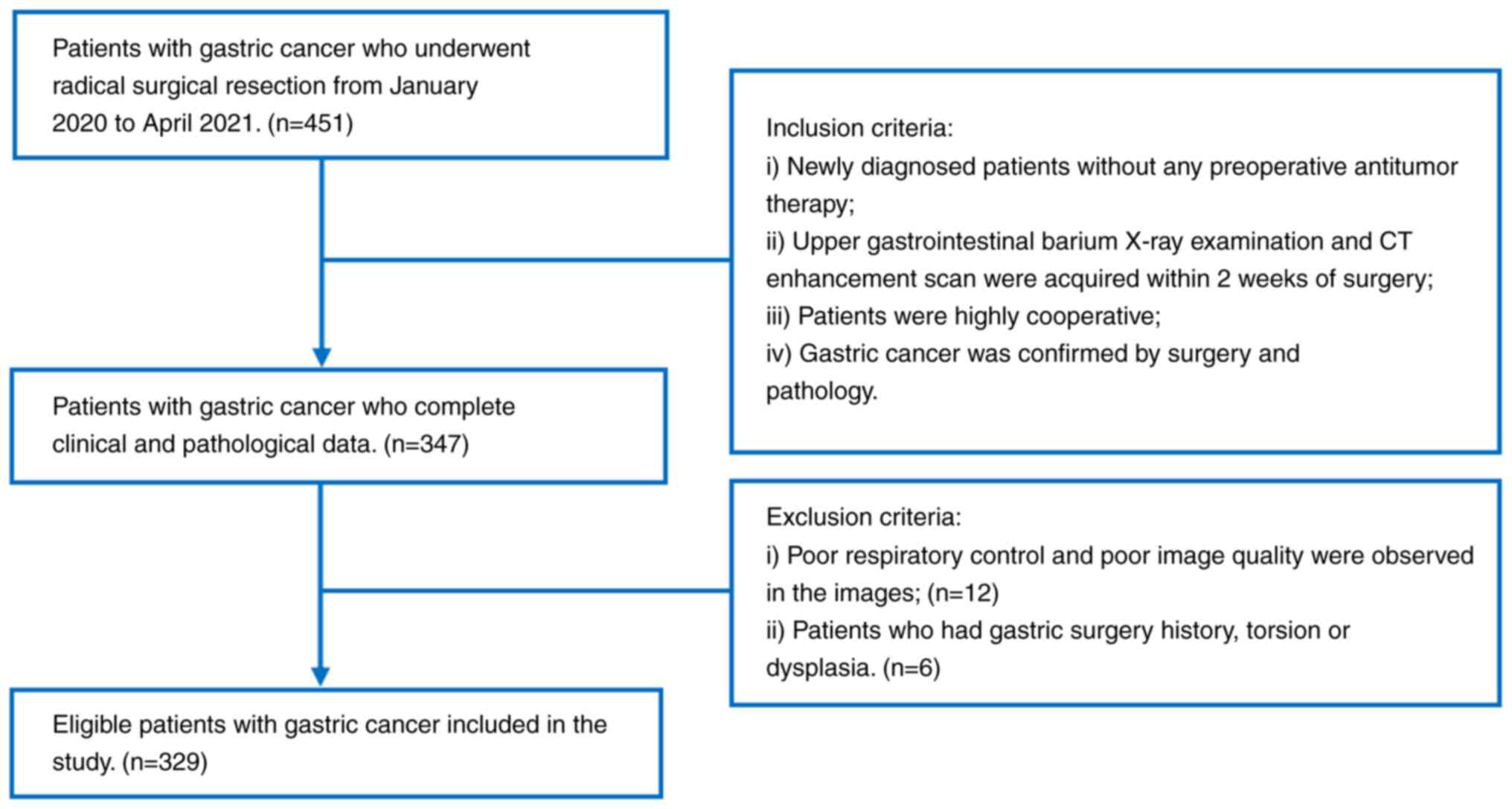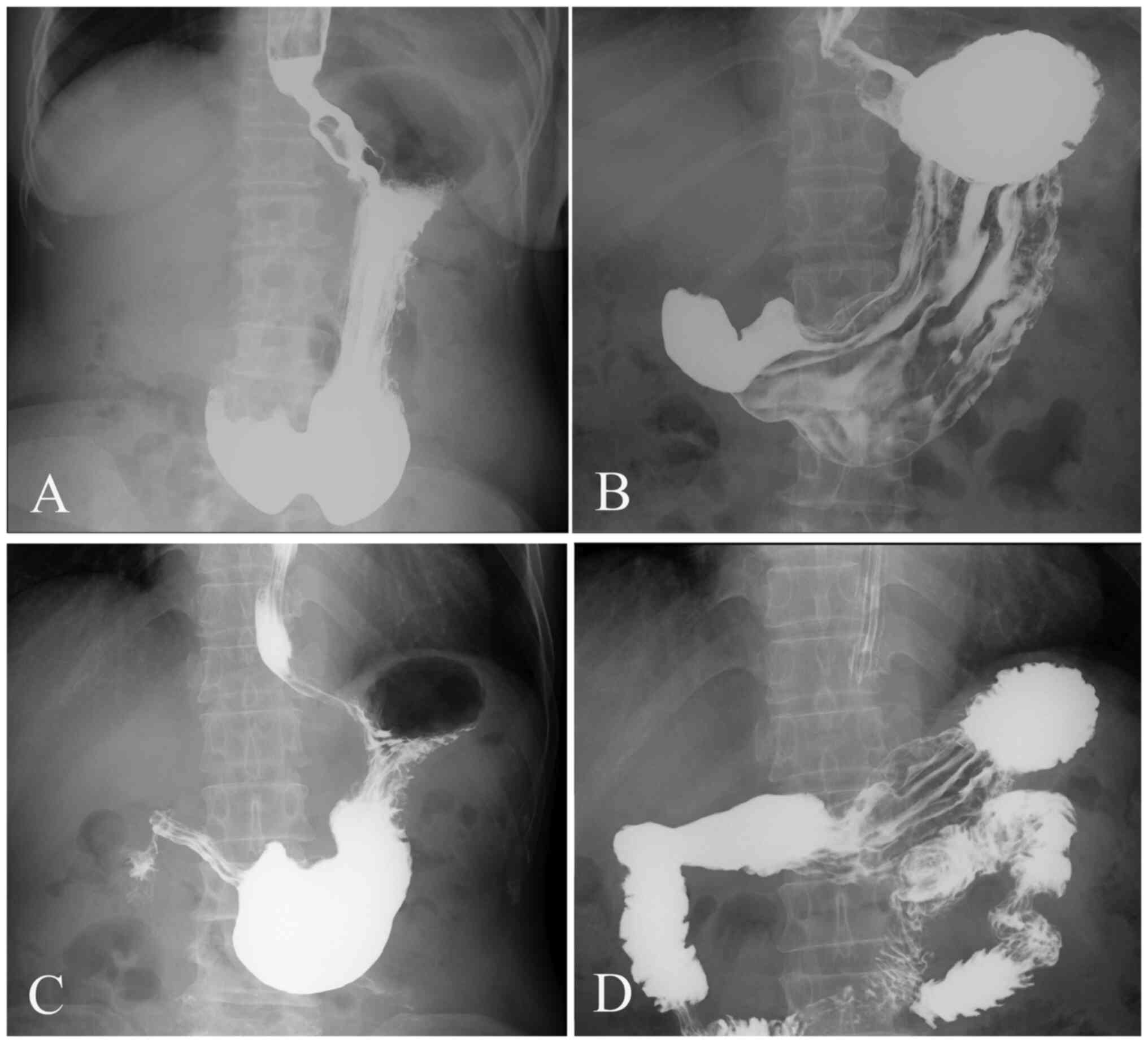|
1
|
Sun KY, Hu HT, Chen SL, Ye JN, Li GH, Chen
LD, Peng JJ, Feng ST, Yuan YJ, Hou X, et al: CT-based radiomics
scores predict response to neoadjuvant chemotherapy and survival in
patients with gastric cancer. BMC Cancer. 20:4682020. View Article : Google Scholar : PubMed/NCBI
|
|
2
|
Wang K, Jiang X, Ren Y, Ma Z, Cheng X, Li
F, Xiao J, Yu Z and Jiao Z: The significance of preoperative serum
carcinoembryonic antigen levels in the prediction of lymph node
metastasis and prognosis in locally advanced gastric cancer: A
retrospective analysis. BMC Gastroenterol. 20:1002020. View Article : Google Scholar : PubMed/NCBI
|
|
3
|
Yamamichi N, Shimamoto T, Hirano C,
Takahashi Y, Minatsuki C, Takeuchi C, Takahashi M, Sakaguchi Y,
Tsuji Y, Niimi K, et al: Clinicopathological features and prognosis
of developed gastric cancer based on the diagnosis of mucosal
atrophy and enlarged folds of stomach by double-contrast upper
gastrointestinal barium X-ray radiography. Clin J Gastroenterol.
14:947–954. 2021. View Article : Google Scholar : PubMed/NCBI
|
|
4
|
Roderburg C, Loosen SH, Jördens MS, Konrad
M, Luedde T, Kostev K and Luedde M: Heart failure and dementia: A
comparative analysis with different types of cancer. Eur Heart J
Open. 1:oeab0032021. View Article : Google Scholar : PubMed/NCBI
|
|
5
|
Yamamichi N, Hirano C, Shimamoto T,
Minatsuki C, Takahashi Y, Nakayama C, Matsuda R, Fujishiro M,
Konno-Shimizu M, Kato J, et al: Associated factors of atrophic
gastritis diagnosed by double-contrast upper gastrointestinal
barium X-ray radiography: A cross-sectional study analyzing 6,901
healthy subjects in Japan. PLoS One. 9:e1113592014. View Article : Google Scholar : PubMed/NCBI
|
|
6
|
Patoulias D, Rafailidis V, Kalogirou M,
Farmakis K, Rafailidis D and Patoulias I: Acute primary
mesenteroaxial gastric volvulus in a 6 years old child; the
contribution of ultrasonographic findings to the prompt diagnosis
(a case report and review of the literature). Folia Med Cracov.
57:47–55. 2017.PubMed/NCBI
|
|
7
|
Wang YJ, Hung KL, Yang JN, Yang JN, Wang
TC and Chin CH: Gastric anatomic type is associated with obesity
and gender. Obes Facts. 9:221–229. 2016. View Article : Google Scholar : PubMed/NCBI
|
|
8
|
Yang ZH, Gao JB, Yue SW, Guo H and Yang
XH: X-ray diagnosis of synchronous multiple primary carcinoma in
the upper gastrointestinal tract. World J Gastroenterol.
17:1817–1824. 2011. View Article : Google Scholar : PubMed/NCBI
|
|
9
|
Zhao L, Huang H, Zhao D, Wang C, Tian Y,
Yuan X, Ma F, Ren H, Zhao Y, Aimaiti S, et al: Clinicopathological
characteristics and prognosis of proximal and distal gastric cancer
during 1997–2017 in china National cancer center. J Oncol.
2019:97840392019. View Article : Google Scholar : PubMed/NCBI
|
|
10
|
Kim DH, Park CH, Park SY, Cho E, Kim HS
and Choi SK: Diagnostic yields of endoscopic ultrasound-guided
fine-needle tissue acquisition according to the gastric location.
Medicine (Baltimore). 100:e264772021. View Article : Google Scholar : PubMed/NCBI
|
|
11
|
Zeydanli T and Kilic HK: Performance of
quantitative CT texture analysis in differentiation of gastric
tumors. Jpn J Radiol. 40:56–65. 2021. View Article : Google Scholar : PubMed/NCBI
|
|
12
|
Lee JS, Kim YS, Kim EY and Jin W:
Prognostic significance of CT-determined sarcopenia in patients
with advanced gastric cancer. PLoS One. 13:e02027002018. View Article : Google Scholar : PubMed/NCBI
|
|
13
|
Zongqiong S, Xiaohong L, Wei C, Jiangfeng
Z, Yuxi G, Zhihui X, Linfang J, Yong P and Gen Y: CT perfusion
imaging of the stomach: A quantitative analysis according to
different degrees of adenocarcinoma cell differentiation. Clin
Imaging. 40:558–562. 2016. View Article : Google Scholar : PubMed/NCBI
|
|
14
|
Xu JJ, Taudorf M, Ulriksen PS, Achiam MP,
Resch TA, Nielsen MB, Lönn LB and Hansen KL: Gastrointestinal
applications of iodine quantification using Dual-Energy CT: A
systematic review. Diagnostics (Basel). 10:8142020. View Article : Google Scholar : PubMed/NCBI
|
|
15
|
Gotoda T, Ishikawa H, Ohnishi H, Sugano K,
Kusano C, Yokoi C, Matsuyama Y and Moriyasu F: Randomized
controlled trial comparing gastric cancer screening by
gastrointestinal X-ray with serology for Helicobacter pylori and
pepsinogens followed by gastrointestinal endoscopy. Gastric Cancer.
18:605–611. 2015. View Article : Google Scholar : PubMed/NCBI
|
|
16
|
Kim YH, Kim JH, Kim H, Kim H, Lee YC, Lee
SK, Shin SK, Park JC, Chung HS, Park JJ, et al: Is the recent WHO
histological classification for gastric cancer helpful for
application to endoscopic resection? Gastric Cancer. 19:869–875.
2016. View Article : Google Scholar : PubMed/NCBI
|
|
17
|
Hu B, El Hajj N, Sittler S, Lammert N,
Barnes R and Meloni-Ehrig A: Gastric cancer: Classification,
histology and application of molecular pathology. J Gastrointest
Oncol. 3:251–261. 2012.PubMed/NCBI
|


















